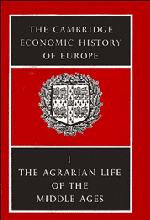Crossref Citations
This Book has been
cited by the following publications. This list is generated based on data provided by Crossref.
Bryer, R. A.
1994.
Accounting for the Social Relations of Feudalism.
Accounting and Business Research,
Vol. 24,
Issue. 95,
p.
209.
Reuter, Timothy
2000.
The New Cambridge Medieval History.
Fossier, Robert
2000.
The New Cambridge Medieval History.
p.
25.
Jones, Richard
2004.
Signatures in the Soil: The Use of Pottery in Manure Scatters in the Identification of Medieval Arable Farming Regimes.
Archaeological Journal,
Vol. 161,
Issue. 1,
p.
159.
BYRES, TERENCE J.
2006.
Differentiation of the Peasantry Under Feudalism and the Transition to Capitalism: In Defence of Rodney Hilton.
Journal of Agrarian Change,
Vol. 6,
Issue. 1,
p.
17.
Shepard, Jonathan
2009.
The Cambridge History of the Byzantine Empire c.500–1492.
Acemoglu, Daron
and
Robinson, James A.
2010.
WHY IS AFRICA POOR?.
Economic History of Developing Regions,
Vol. 25,
Issue. 1,
p.
21.
Langdon, John
and
Claridge, Jordan
2011.
Transport in Medieval England.
History Compass,
Vol. 9,
Issue. 11,
p.
864.
Bisman, Jayne E.
2012.
Budgeting for famine in Tudor England, 1527–1528: social and policy perspectives.
Accounting History Review,
Vol. 22,
Issue. 2,
p.
105.
2014.
Mining and Communities.
Ravelli, Quentin
2019.
Le capitalisme a-t-il une date de naissance ?.
Tracés,
p.
29.
Zhang, Diyang
Lu, Yujie
Fang, Xiuqi
Ye, Yu
Zhang, Chengpeng
and
Zheng, Xue
2023.
Identifying a scenario for preindustrial cropland cover using cultivation data: A case study of France, Germany and Italy.
Anthropocene,
Vol. 43,
Issue. ,
p.
100388.



